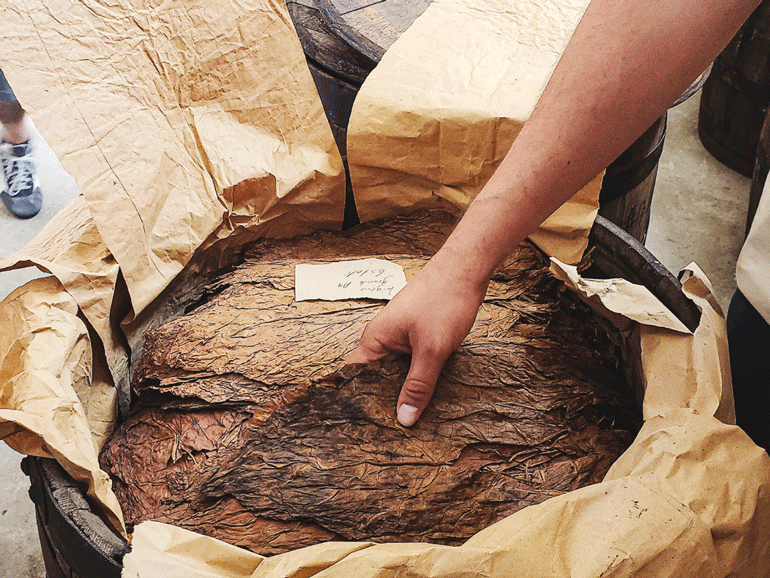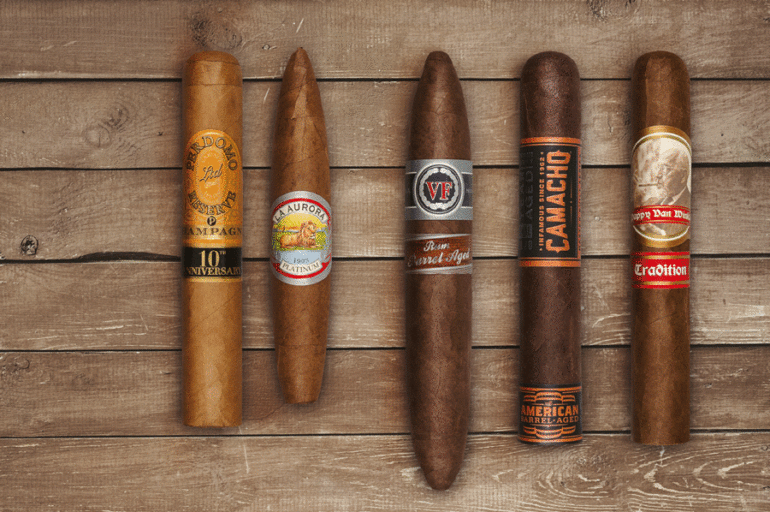From Barrel to Box (Cigar Journal): Difference between revisions
(New) |
m (Hutah moved page From Barrel to Box to From Barrel to Box (Cigar Journal)) |
(No difference)
| |
Latest revision as of 09:34, 31 December 2022
Using wood to add new flavor characteristics to beverages is not a new concept. Over the centuries, wine and other beverage producers have been benefiting from the use of wood to age and add complexity and new organoleptic characteristics to their products. In recent years, with the growth of the consumer market, producers have been searching for different uses of a wider variety of casks to differentiate their products and explore new perceptions. When it comes to whisky, aging the product in casks previously used to age port wine, sherry and rum is becoming increasingly popular. Although the use of casks to ferment or age tobacco leaves is a relatively new concept compared to beverages, the technique is now used more often in the cigar industry. The first brand to reportedly benefit from these processes is Cohiba. Created in 1966, Cohiba cigars always caught attention for their complexity and exclusivity. Eduardo Rivero, the man behind the early blends of the brand, wanted this new brand to represent the highest expression of the Cuban tobacco and he decided to put the tobacco through an extra fermentation in casks to provide more balance and complexity. He believed this process helped to eliminate impurities and provide refinement to the tobacco oils, flavors and aromas. Using barrels to ferment their tobacco along with the use of the best raw materials, controlled and limited production helped to construct the aura of the most coveted Cuban cigar brand. At the turn of the century and with the brands competing in a demanding market eager for innovation, many manufacturers started to look for ways of adding appeal and complexity to their cigars.
The Perdomo Reserve 10th Anniversary Champagne Series was where the technique of bourbon barrelaging tobaccos started for Perdomo. This special aging process was a Perdomo family secret for years, and it was Nicholas Perdomo Senior who named the beautiful bourbon-barrelaged Connecticut wrappers the “Champagne of Wrappers,” says Arthur Kemper of Perdomo Cigars. The experiment was so successful that the manufacture now uses barrel-aged wrappers in all of their premium cigars.
Perdomo also has a line that ages all the leaves used in the cigar in bourbon casks. The Perdomo Double Aged 12-Year Vintage carries the number 12 because the tobacco used is aged in bales for 10 years and then two extra years in barrels, whish makes this series an extremely limited edition.
A similar process happened with La Aurora, which launched its first line using barrel-aged tobacco in 2004 with the La Aurora Preferidos Platinum, Emerald and Gold. The result of this experience was so positive that the manufacturer extended the barrel-aged process as extra-aging for all the company’s super premium lines. Gustavo Velayos, marketing director from La Aurora, says that only the best tobacco undergoes this extra aging process. “We can consider these tobaccos the best of the best. The ones that exceed our quality standards. And that’s why we can add even more complexity to our cigars,” says Velayos. Although many might think that the intention of this kind of fermentation is to add the taste of the spirit itself to the tobacco leaf, the idea is actually to add sweet and oak notes and to lower the bitter tastes of the tobacco even more. VegaFina launched two limited editions using tobacco aged in rum barrels. The first one was released in 2016, a Salomones format, and the second in 2018, called Galeones. “I think that cigar enthusiasts expect to find caramel and the sweet touch of rum in the cigar they’re smoking, without losing the tobacco background flavor,” says Celia Sánchez Alarcón, international brand manager of Tabacalera Premium Cigars.
Another company that uses barrel-aged tobacco in its cigars is Davidoff. They launched their first line of cigars using barrel-fermented tobacco in 2016 with the Camacho American Barrel Aged that was matured in bourbon casks.
It took some time for the company to find the exact type of tobacco and fermenting time. “Of course, it was a bit of trial and error, since we didn’t know exactly which variety of tobacco to use and for how long we needed to ferment it. We then soon found out the best time frame was five to six months and using a tobacco variety that is thicker in structure,” explains Sam Reuter, director of Oettinger Davidoff AG. “The benefits are that we focus on a natural process and not, for example, vaporing the tobacco with bourbon or whisky. We apply either bourbon or whisky to the inner side of the barrels and then fill them up with tobacco,” he adds.
It was a successful introduction and also an eye-opener for Davidoff to use barrel-aged tobacco in some of their blends. It did not take long for the company to launch a second experiment, this time under the Davidoff brand with the Winston Churchill Late Hour. Another factor that motivated many manufacturers to try this new experiment was the growing popularity of the concept of pairing. Cigar enthusiasts have been looking for a smooth and harmonic transition between the cigar and their favorite spirit. This explains the preference for using rum, bourbon or whisky casks when it comes to aging or fermenting tobacco leaves. Drew Estate not only decided to use bourbon barrels but also launched a line named after one of the rarest and finest bourbon brands. Since its launch, the Pappy Van Winkle line has been using the fire-curing process; the tobacco then undergoes fermentation in the brand-coveted bourbon casks. Curing and fermentation give this line a strong character that makes the pairing with the American spirit an easy choice.
As the concept of pairing receives more attention from cigar smokers, beverage companies are observing this demand and have also been focusing on this market. In recent years, many companies have launched products promoting the pairing of its spirits with cigars. This was the case with the Cohiba cognac produced by Martell and the Havana Club Unión. This was developed to be the perfect pairing with rum and the Cohiba Siglo VI in a collaboration between the rum master Asbel Morales and cigar expert and director of the Habanos sommelier school in Cuba, Fernando Fernandez. Although the process of fermentation and aging and the period might vary from company to company, the truth is that this new trend has been a success among critics and consumers and seems to be getting more space in manufacturers’ portfolios every year. “We are very proud of our two limited editions because not only were they a great sales success but they also got excellent scores from the Cigar Journal tasting panel, receiving 92 and 91 points, respectively,” says Celia Sánchez Alarcón from Tabacalera Premium Cigars, in what just seems to justify the trend.[1]

